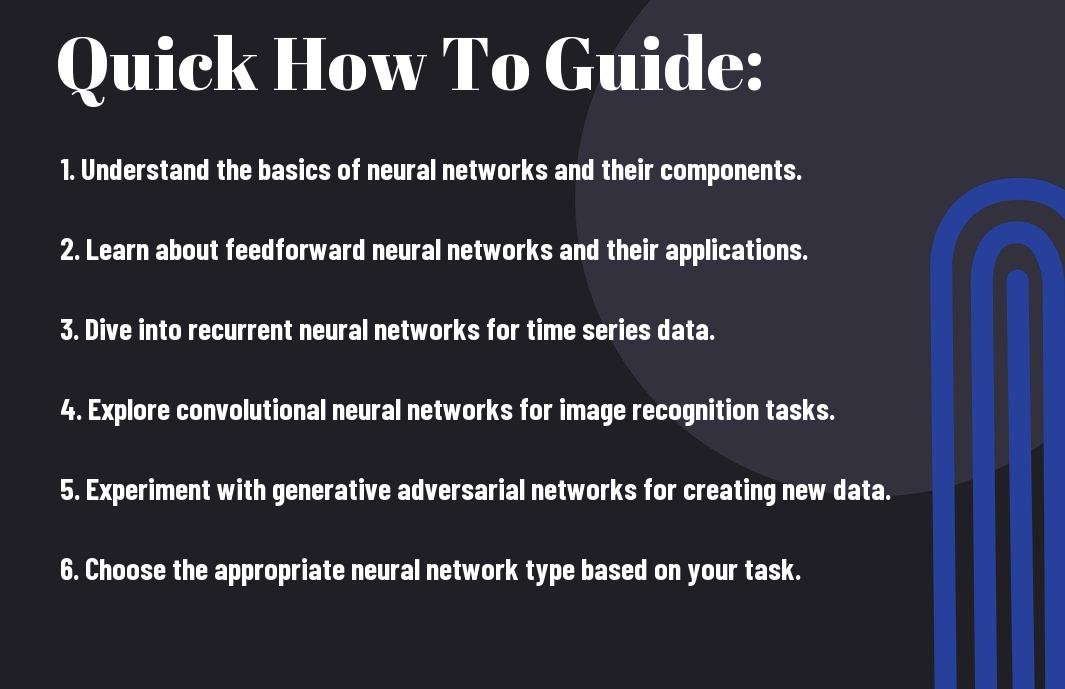Networks are at the forefront of artificial intelligence, shaping industries and revolutionizing technology. In this comprehensive guide, we examine into the world of neural networks, illuminating the various types and their unique applications. From convolutional networks optimizing image recognition to recurrent networks excelling in sequential data analysis, each type offers distinct advantages in solving complex problems. Understanding these neural network variations is paramount for anyone delving into machine learning and AI, as their versatility and power continue to push boundaries in the digital landscape.

Key Takeaways:
- Neural Network Types: There are several types of neural networks, including convolutional neural networks (CNNs), recurrent neural networks (RNNs), and generative adversarial networks (GANs).
- Uses of Different Neural Networks: CNNs are commonly used for image recognition, RNNs for natural language processing tasks, and GANs for generating new data based on existing data.
- Deep Learning: Neural networks, especially deep neural networks with multiple layers, have revolutionized the field of artificial intelligence and are particularly effective for complex tasks requiring pattern recognition.
- Transfer Learning: Transfer learning allows neural networks to leverage knowledge gained from one task to perform better on another related task, significantly reducing the need for large amounts of labeled data.
- Choosing the Right Neural Network: It is crucial to understand the specific requirements of a task to select the most appropriate type of neural network, taking into consideration factors such as data type, scale, and complexity of the problem.


Different Types of Neural Networks
There’s a vast array of neural network architectures tailored for different tasks in the field of artificial intelligence. Understanding the distinctions between these networks is crucial for selecting the appropriate model for a specific problem. Let’s explore some of the most commonly used neural networks:
- Feedforward Neural Networks
- Recurrent Neural Networks (RNNs)
- Convolutional Neural Networks (CNNs)
- Deep Belief Networks (DBNs)
- Long Short Term Memory Networks (LSTMs)
Feedforward Neural Networks
There’s a simple structure to feedforward neural networks where information moves in one direction, from input nodes through hidden layers to output nodes. These networks are extensively used in tasks like image and speech recognition.
- What is the basic structure of feedforward neural networks?
- How are weights adjusted in feedforward neural networks?
- Explain the concept of backpropagation in feedforward neural networks.
Recurrent Neural Networks (RNNs)
RNNs are designed to handle sequential data by retaining memory of past inputs through loops in the network. They are commonly employed in natural language processing tasks like language translation and sentiment analysis.
- How do recurrent neural networks differ from feedforward networks?
- What is the significance of the vanishing gradient problem in RNNs?
- Explain the architecture of Long Short Term Memory (LSTM) networks.
RNNs excel at tasks that depend on the sequence of inputs, making them ideal for applications like speech recognition and time series prediction. They can capture patterns in sequential data that other types of neural networks might miss.
- Describe the applications of recurrent neural networks.
- How do RNNs overcome the limitations of traditional feedforward networks?
- Explain the impact of long sequences on the performance of RNNs.
Convolutional Neural Networks (CNNs)
If there’s a need to process grid-like data like images, Convolutional Neural Networks (CNNs) are the go-to choice. Their ability to detect spatial hierarchies makes them exceptionally well-suited for image and video analysis tasks.
- How do convolutional neural networks differ from other types of neural networks?
- Explain the concept of feature maps in CNNs.
- What is the role of pooling layers in convolutional neural networks?
If implemented correctly, CNNs can accurately identify objects in images, recognize faces, and even assist in self-driving car applications. Their ability to learn hierarchical patterns in data sets them apart in the field of computer vision.
- Discuss the advantages of using convolutional neural networks in image recognition.
- How are CNNs utilized in object detection algorithms?
- Explain the training process of convolutional neural networks.
Deep Belief Networks (DBNs)
Neural networks are arranged in multiple layers of hidden units in Deep Belief Networks (DBNs), allowing them to learn intricate patterns within data. These networks are commonly used in recommendation systems and speech recognition.
- What is the structure of Deep Belief Networks?
- How are Deep Belief Networks trained compared to other neural networks?
- Explain the concept of unsupervised pre-training in DBNs.
Neural networks in DBNs operate through a process of unsupervised learning, where they learn to represent the input data in a way that facilitates the classification task. This approach makes them effective in handling complex patterns and making accurate predictions.
- Discuss the applications of Deep Belief Networks in real-world scenarios.
- How do Deep Belief Networks differ from traditional neural networks?
- Explain the role of generative learning in Deep Belief Networks.
Long Short Term Memory Networks (LSTMs)
To model temporal sequences and overcome the vanishing gradient problem in RNNs, Long Short Term Memory Networks (LSTMs) are employed. LSTMs have the ability to retain information for long periods, making them ideal for tasks requiring memory of past events.
- What makes Long Short Term Memory Networks suitable for handling long sequences?
- How do LSTMs address the vanishing gradient problem?
- Discuss the internal structure of Long Short Term Memory cells.
RNNs, especially LSTMs, have revolutionized the field of sequence modeling by enabling more sophisticated analysis of sequential data. Their unique architecture allows them to handle dependencies over long sequences, making them indispensable in tasks like speech recognition, language translation, and music generation.
- Explain the advantages of using Long Short Term Memory Networks over traditional RNNs.
- Discuss the applications of LSTMs in natural language processing.
- How do LSTMs contribute to the field of time series forecasting?
Practical Applications of Neural Networks
To truly understand the impact and versatility of neural networks, it is important to explore their practical applications in various fields. From image and speech recognition to natural language processing, predictive analytics, autonomous vehicles and robotics, healthcare, and bioinformatics, neural networks have revolutionized modern technology and continue to push the boundaries of what is possible.
1. Image classification and object detection
2. Voice recognition and speech synthesis
3. Sentiment analysis and text generation
4. Time series forecasting and anomaly detection
5. Autonomous navigation and robotic control
6. Medical image analysis and drug discovery
7. Fraud detection and risk assessment
Image and Speech Recognition
To say that neural networks have revolutionized image and speech recognition would be an understatement. These networks can now accurately identify objects and transcribe speech with remarkable precision, enabling advancements in fields such as self-driving cars, virtual assistants, and medical diagnostics.
1. Generate image captions
2. Recognize facial expressions
3. Transcribe audio to text
4. Identify objects in images
5. Synthesize speech from text
Natural Language Processing and Translation
To keep up with the ever-growing demand for multilingual communication and efficient text processing, neural networks have been instrumental in advancing natural language processing and translation technologies. These networks power various language-related applications, facilitating effective communication across borders and languages.
1. Summarize long texts
2. Translate between languages
3. Detect sentiment in text
4. Answer questions from text
5. Generate new text based on input
Some of the most significant advancements in recent years have been in the field of natural language processing and translation. Neural networks now possess the ability to not only understand text but also respond to it in a meaningful and contextually appropriate manner, mimicking human-like interactions in communication tasks.
1. Generate text based on keywords
2. Complete sentences in context
3. Help in language learning
4. Provide writing prompts
5. Assist in content creation
Predictive Analytics and Data Forecasting
Processing vast amounts of data to make accurate predictions and forecasts is a challenging task that neural networks excel at. By leveraging complex algorithms, these networks have been instrumental in enhancing predictive analytics and data forecasting capabilities across various industries.
1. Predict stock market trends
2. Forecast weather patterns
3. Analyze consumer behavior
4. Detect credit card fraud
5. Optimize supply chain management
Image recognition and predictive analytics have been key areas where neural networks have made significant inroads. Whether it’s identifying patterns in large datasets or predicting future outcomes based on historical data, these networks play a vital role in shaping decision-making processes and driving business insights.
1. Analyze time-series data
2. Forecast sales trends
3. Detect anomalies in data
4. Optimize marketing strategies
5. Improve customer retention
Autonomous Vehicles and Robotics
Applications of neural networks in autonomous vehicles and robotics have transformed the way we perceive transportation and automation. With the ability to process vast amounts of real-time data and make split-second decisions, these networks are at the forefront of enabling self-driving cars, drones, and robotic systems.
1. Navigate autonomously
2. Control robotic arms
3. Recognize hand gestures
4. Monitor surroundings for safety
5. Plan optimal routes
Any discussion on autonomous vehicles and robotics would be incomplete without acknowledging the pivotal role neural networks play in ensuring the safety, efficiency, and reliability of these systems. From self-driving cars to industrial robots, these networks enable intricate decision-making processes critical to the success of autonomous technologies.
1. Enhance human-robot collaboration
2. Improve manufacturing processes
3. Optimize warehouse operations
4. Ensure precise surgical procedures
5. Monitor patient health in real-time
Healthcare and Bioinformatics
It is fascinating to witness the impact of neural networks on healthcare and bioinformatics, where these technologies are revolutionizing patient care, disease diagnosis, drug development, and genetic research. By analyzing complex medical data and identifying patterns, neural networks are driving innovations that have the potential to save lives and improve the quality of healthcare globally.
1. Diagnose diseases from medical images
2. Predict patient outcomes
3. Identify drug interactions
4. Analyze genomic sequences
5. Personalize treatment plans
For healthcare and bioinformatics, the integration of neural networks has opened up a world of possibilities in personalized medicine, disease prevention, and medical research. From early detection of illnesses to developing targeted therapies, these networks are transforming the healthcare landscape by providing valuable insights and innovative solutions.
1. Assist in medical image analysis
2. Predict treatment response
3. Analyze patient genomic data
4. Improve drug discovery processes
5. Enhance rare disease diagnosis
Robotics, with its intersection of artificial intelligence and mechanical engineering, brings a myriad of possibilities. From assisting in repetitive tasks in manufacturing to precision surgeries in healthcare, the potential applications are vast. While the advancements are promising, it’s important to recognize the critical need for stringent safety protocols and ethical considerations to harness the positive aspects of these technologies while mitigating any potential risks.
How-To Optimize Neural Network Performance
For a neural network to perform optimally, it’s crucial to fine-tune various components such as the network architecture, training process, and hyperparameters. This chapter researchs into strategies to optimize neural network performance and improve efficiency.
- How to adjust learning rates for faster convergence
- Techniques for regularization to prevent overfitting
- The importance of data preprocessing for improved outcomes
- Strategies for tuning hyperparameters for optimal performance
- Implementing early stopping to prevent model overfitting
Choosing the Right Neural Network Type
On your journey to optimizing neural network performance, selecting the right type of neural network is fundamental. Different neural network architectures are tailored for specific tasks like image recognition, natural language processing, or time series forecasting. Choosing the appropriate network type can significantly impact the success of your model.
- How to decide between feedforward, convolutional, and recurrent neural networks
- Selecting the best architecture for your specific data and task
- Understanding the advantages of different neural network types
- Considering pre-trained models for transfer learning
- When to use deep learning versus traditional machine learning models
Factors to Consider: Data, Computation, and Model Complexity
On the optimization path, considering factors such as the quality and quantity of data, computational resources, and model complexity is vital. The interplay of these elements can greatly influence the efficiency and effectiveness of your neural network.
- Balancing data size and diversity for robust model training
- Evaluating hardware requirements for neural network training
- Understanding the trade-offs between model complexity and generalization
- How data imbalance can affect model performance
- Incorporating techniques like data augmentation to enhance training data
Complexity:
- Data quality and quantity, computational resources, and model complexity are critical factors in optimizing neural networks. Balancing these elements is key to achieving desired performance levels. Knowing how to navigate these complexities is vital for successful neural network implementation.
Tips for Training and Validation
Validation:
For optimal neural network performance, training and validation processes play a pivotal role. Properly setting up training-validation splits, monitoring metrics, and fine-tuning the model based on validation results are vital strategies for achieving high performance and generalization.
- The significance of data preprocessing in enhancing training efficiency
- Techniques for managing overfitting during training
- Setting up a robust validation strategy for model evaluation
- Leveraging cross-validation for more reliable performance estimation
- Incorporating techniques like dropout to prevent overfitting
Validation:
- Training and validating neural networks effectively is key to achieving optimal performance. This stage is crucial for fine-tuning models and ensuring they generalize well to unseen data. This iterative process helps in refining the model architecture and hyperparameters for better results.
Overfitting vs. Underfitting: A Balancing Act
The balance between overfitting and underfitting is critical in neural network optimization. Striking this balance ensures that the model neither memorizes the training data nor oversimplifies the underlying patterns, leading to poor generalization. Techniques like regularization and early stopping can help maintain this delicate equilibrium for optimal performance.
- Understanding the causes and consequences of overfitting and underfitting
- Techniques to recognize and mitigate overfitting and underfitting
- How to set hyperparameters to prevent overfitting or underfitting
- Implementing techniques like dropout and batch normalization for regularization
- Balancing model complexity with data fitting for better generalization
The balance between overfitting and underfitting is crucial for neural network success. While overfitting leads to memorizing noise in the data, underfitting oversimplifies the model, missing underlying patterns. Striking a balance between complexity and generalization is key. Knowing how to navigate this fine line can lead to high-performing models that generalize well to new data.
Best Practices and Advanced Techniques
All successful implementation of neural networks requires a deep understanding of best practices and advanced techniques to ensure optimal performance. Here are some key strategies to consider:
- Regularization and Dropout Techniques
- Transfer Learning and Fine-tuning
- Hyperparameter Optimization
- Scalability and Deployment Strategies
Regularization and Dropout Techniques
Some of the most critical techniques in neural network training are regularization and dropout. These methods help prevent overfitting and improve the generalization of the model. Regularization techniques such as L1 and L2 regularization add a penalty to the loss function, discouraging overly complex models. Dropout randomly drops out a fraction of neurons during training, forcing the network to learn more robust features. By incorporating these techniques, models can achieve better performance on unseen data and handle noisy inputs more effectively.
- Explain the concept of dropout regularization.
- How does L2 regularization prevent overfitting in neural networks?
- Techniques to implement dropout in a neural network.
- Advantages of using dropout in deep learning models.
Transfer Learning and Fine-tuning
Transfer learning involves using pre-trained models on a similar task and fine-tuning them for a specific problem. This approach leverages the knowledge encoded in the pre-trained model and significantly reduces training time and data requirements. Fine-tuning allows adjusting the pre-trained model’s parameters to fit the new task, making it a powerful tool for tasks with limited data. By implementing transfer learning and fine-tuning, developers can create high-performance models with minimal resources and time investment.
- How does transfer learning accelerate model training?
- Steps involved in fine-tuning a pre-trained model.
- Benefits of transfer learning in deep learning applications.
- Techniques to adapt a pre-trained model to a new task.
Transfer learning and fine-tuning are imperative techniques in deep learning that enable developers to build powerful models efficiently. By leveraging existing pre-trained models’ knowledge and adapting them to new tasks, developers can achieve superior performance with reduced computational resources and time.
- Explain the concept of transfer learning in neural networks.
- How does fine-tuning improve model performance in deep learning?
- Benefits of transfer learning compared to training from scratch.
- Techniques for transferring knowledge from pre-trained models.
Hyperparameter Optimization
Techniques for optimizing hyperparameters, such as grid search, random search, and Bayesian optimization, are crucial for achieving optimal model performance. Hyperparameters govern the behavior and performance of neural networks, and selecting the right values can significantly impact the model’s effectiveness. By systematically tuning hyperparameters using various optimization techniques, developers can fine-tune models for better accuracy and generalization on diverse datasets.
- Explain the concept of hyperparameter optimization.
- Techniques for tuning hyperparameters in deep learning models.
- Benefits of Bayesian optimization in hyperparameter tuning.
- Strategies for efficient hyperparameter search.
Assuming the right hyperparameters is crucial as it directly affects the model’s performance. By systematically tuning hyperparameters using optimization techniques, developers can enhance the model’s accuracy and efficiency in handling various tasks.
- How do hyperparameters affect neural network performance?
- Benefits of Bayesian optimization compared to grid search for hyperparameter tuning.
- Ways to automate hyperparameter optimization for deep learning models.
- Strategies to prevent overfitting during hyperparameter search.
Scalability and Deployment Strategies
Dropout techniques are instrumental in training robust neural networks that can generalize well on unseen data. By randomly deactivating a percentage of neurons during each training iteration, dropout prevents neural networks from relying too heavily on individual neurons, reducing overfitting and improving the model’s performance.
- Explain the concept of dropout regularization.
- How does dropout prevent overfitting in neural networks?
- Techniques to implement dropout in a neural network.
- Benefits of using dropout in deep learning models.
To ensure successful deployment of neural networks in production environments, developers need to consider scalability and deployment strategies. These strategies involve optimizing models for efficiency, selecting appropriate hardware for deployment, and incorporating proper monitoring and maintenance protocols to ensure optimal performance in real-world applications.
- Strategies for scaling neural network models for production deployment.
- Best practices for deploying deep learning models in real-world applications.
- Hardware considerations for deploying large-scale neural networks.
- Techniques for monitoring and maintaining neural network performance post-deployment.
To wrap up
Taking this into account, exploring different types of neural networks and their uses can greatly enhance the understanding of deep learning applications. From Convolutional Neural Networks (CNNs) for image recognition to Recurrent Neural Networks (RNNs) for sequential data analysis and Multilayer Perceptrons (MLPs) for general-purpose machine learning tasks, each type has its unique strengths and applications. To examine deeper into the analysis of these neural networks, you can refer to Analyzing Types of Neural Networks in Deep Learning. Understanding the differences and capabilities of these networks can help data scientists and machine learning enthusiasts make informed decisions when choosing the right model for their specific use case.
FAQ
Q: What is a neural network?
A: A neural network is a computer system modeled after the human brain, composed of interconnected nodes called neurons that work together to process complex information and learn patterns.
Q: What are the different types of neural networks?
A: Some common types of neural networks include feedforward neural networks, convolutional neural networks (CNN), recurrent neural networks (RNN), and deep neural networks (DNN).
Q: What is the use of a feedforward neural network?
A: Feedforward neural networks are often used for tasks like image recognition, text analysis, and regression problems where data flows in one direction without feedback loops.
Q: How are convolutional neural networks (CNN) utilized?
A: CNNs are specifically designed for image recognition tasks due to their ability to retain spatial hierarchies and identify patterns in images through convolutional layers and pooling layers.
Q: When should recurrent neural networks (RNN) be applied?
A: RNNs are best suited for sequential data processing tasks such as speech recognition, natural language processing, and time series analysis where past information is crucial for predicting future outcomes.







